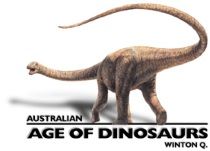Kayentapu
Pronunciation
Kah-YEN-tah-puss
Meaning
Kayenta foot
Period
Early–Middle Jurassic
Ichnospecies in Australia
Indeterminate
Origin and other locations
First identified in North America; records also from Europe, Asia and Africa.
Australian use and location
Southeast Queensland, Walloon Coal Measures.
Description
Theropod tracks up to ~70 cm long have been known from southeast Queensland since at least the 1930s. Most of these tracks were discovered in collieries (underground coalmines) that were dug with hand tools rather than machinery. Fairly frequently, infills (casts) of tracks were recognised in the roofs of colliery tunnels, implying that the layer preserving the true tracks (the moulds) was either the coal itself, or a rock layer that had been removed along with, or in order to access, the coal.
Many reports of footprints from the Rosewood and Oakey regions were made in the 1930s and 1950s. As manual underground mining halted, and automated open-cut mining became more prevalent, discoveries of tracks became increasingly infrequent. Most of the collieries were closed and/or filled in, meaning that the only evidence we have of most of these tracks comes from the brief published reports, photographs and replicas. However, in a few rare cases, actual tracks were also removed.
In 1971, palaeontologist Hartmut Haubold named a pair of fairly large theropod tracks from Westvale No. 5 colliery near Rosewood, despite having seen them only in a photograph published by Alan Bartholomai in 1966. Haubold named the tracks Changpeipus bartholomaii, thereby referring them to an ichnogenus that had first been identified in China. However, neither Haubold nor anyone else ever described the tracks in full, and other palaeontologists later regarded the original Changpeipus as being the same as Eubrontes ('true thunder') or Kayentapus.
In 2020, Anthony Romilio and colleagues published a study of Jurassic dinosaur footprints from southeast Queensland. In so doing, they assigned the footprints named by Haubold, and many more from several other collieries, to the ichnogenus Kayentapus. The ichnogenus Kayentapus, erected by Samuel Welles, was originally based on theropod footprints from the Lower Jurassic Kayenta Formation of Arizona (hence their name, "Kayenta foot"). However, since 1971, numerous Jurassic theropod footprints from Europe, Asia, Africa, and elsewhere in North America, have been assigned to this ichnogenus as well. Now, footprints from Australia have, too.
Although the validity of Kayentapus is still open to debate (some palaeontologists consider it to be the same as either Eubrontes or Grallator), the tracks assigned to Kayentapus from southeast Queensland demonstrate that large theropods (possibly 8–9 metres long) lived in Australia during the Jurassic Period. Hopefully, in time, additional evidence of these theropods will come to light.

